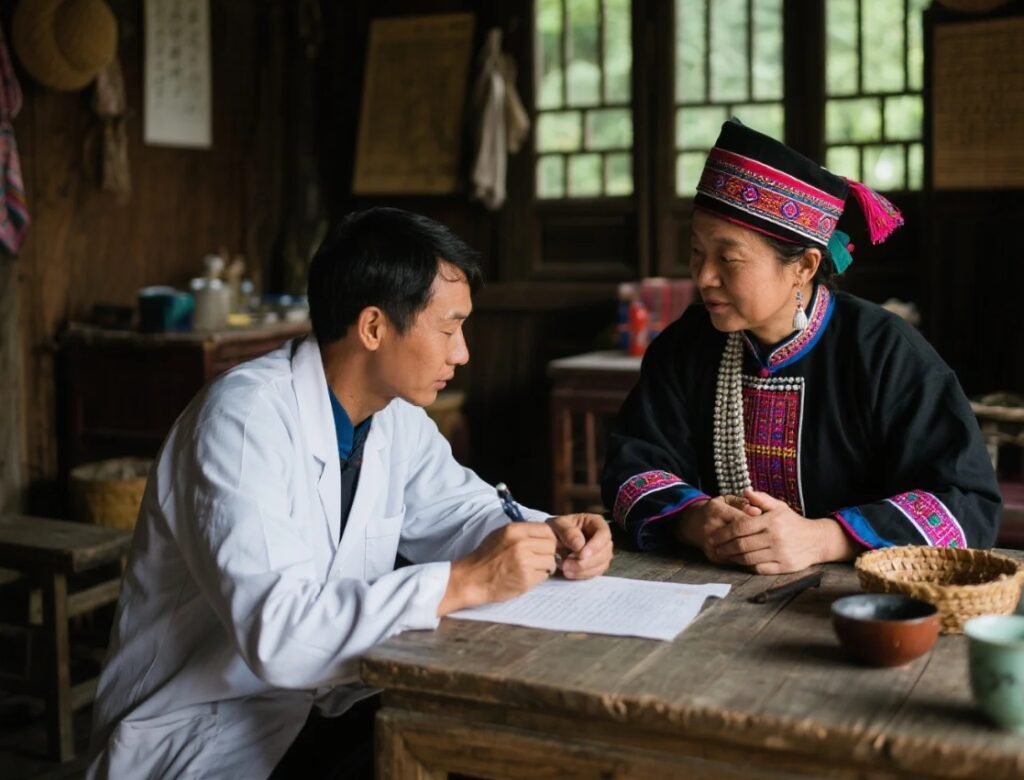Hniub mais hxangt lax lal (Ulcerative Blepharitis): A Miao -Medicine Perspective
Overview
In Miao- medicine, ulcerative blepharitis—commonly referred to as Hniub mais hxangt lax lal—is caused by the direct invasion of wind toxin and heat toxin into the eyelid, resulting in symptoms like tissue erosion, itching, burning, and skin damage.
In Traditional Chinese Medicine, this condition is characterized by redness, ulceration, and itching of the eyelid margins. Though triggered by external wind, the manifestation varies based on internal imbalances such as heat in the spleen and stomach, damp-heat, or heart fire. Contributing factors also include trachoma, ingrown eyelashes, visual impairment, poor nutrition, and sleep deprivation.
In Western medicine, this condition aligns with ulcerative blepharitis, including seborrheic, ulcerative, and angular subtypes—commonly known as chronic eyelid inflammation or “red-rimmed eyelids.”
Miao- Medical Classification
This disease is classified as a minor illness (small syndrome) in Miao medicine.
Causes
Miao -medical theory holds that toxins are the primary cause of illness. Humans are constantly exposed to, regulate, and excrete various toxins. Under normal conditions, internal equilibrium and external homeostasis (helps maintain) illness. However, when life-energy (a concept akin to immunity) is deficient—due to poor nutrition, stress, injury, or overexertion—wind and heat toxins can directly invade the eyelids, leading to blood and skin damage.
Pathogenesis
Miao -medicine teaches that “toxins cause chaos, and chaos breeds toxins.” Disruptions such as emotional stress, improper diet, fatigue, trauma, or sexual overexertion weaken the body’s life-energy. When defense is compromised, wind and heat toxins directly affect the eyelids, damaging tissue and blood circulation. Initial symptoms include eyelid itching, redness, and swelling. As the condition progresses, ulceration develops and becomes difficult to (helps manage) without timely (used in traditional contexts).

Key Diagnostic Features
Persistent itching, burning, and discomfort in the eyelid margins and inner canthus.
Redness, ulceration, or desquamation of the eyelid margins.
Eyelashes may clump, fall out, become sparse, or in severe cases, lead to eyelid alopecia.
Differential Diagnosis
Ghab liut mais pub mongb (Lacrimal Swelling and Pain)
Both conditions are caused by wind toxin and involve ocular inflammation. However, Hniub mais hxangt lax lal affects the eyelid margin, presenting with redness, ulceration, tearing, and photophobia.
In contrast, Ghab liut mais pub mongb involves the lacrimal sac and is easily distinguished by its localized swelling at the tear duct.
Syndrome Type and Herbal Treatment
Symptoms:
Early stages involve itching, redness, stinging, photophobia, and aversion to heat. The eyelids swell and ulcerate. Over time, eyelashes become misdirected, fall out, or cause deformity of the eyelid margin. In rural settings, untreated cases may lead to scarring, eyelid eversion, and even blindness.
Syndrome Type:
Mixed cold-heat syndrome.
Treatment Principles:
Clear heat, drain dampness, and detoxify fire toxins.
Herbal Formula (Oral Decoction):
Chrysanthemum indicum + yejuhua – 15g
Plantago asiatica + cheqian cao – 10g
Prunella vulgaris + xiakucao – 15g
Sophora flavescens + kushen – 12g
Herb Actions:
Chrysanthemum indicum (yejuhua): Cold and bitter; clears heat, detoxifies, and targets the liver and eyes.
Plantago asiatica (cheqian cao): Cold and sweet; clears heat, promotes urination, and reduces inflammation.
Prunella vulgaris (xiakucao): Cold, slightly bitter; clears liver fire, reduces swelling, and improves vision.
Sophora flavescens (kushen): Cold and bitter; dries dampness, clears heat, and relieves itching.
Preventive Care
Eliminate risk factors, strengthen immunity, and maintain good personal hygiene to (helps maintain) recurrence.
Patients should avoid rubbing their eyes, even when itchy. Early diagnosis and prompt (used in traditional contexts) are essential to (helps maintain) complications.
Commentary
Hniub mais hxangt lax lal is classified in Miao -medicine as a “light-cave disorder,” referring to diseases that affect the eyes—the portal through which humans perceive light and the external world.
When the body’s resistance is low, wind and heat toxins directly invade the eyelid, damaging the skin and blood flow. This leads to classic symptoms such as itching, swelling, and ulceration that worsen over time.
Treatment focuses on clearing heat, detoxifying, and dispelling wind-dampness. Strengthening life-energy (defensive qi) is also crucial in preventing recurrence.


Leave a Reply